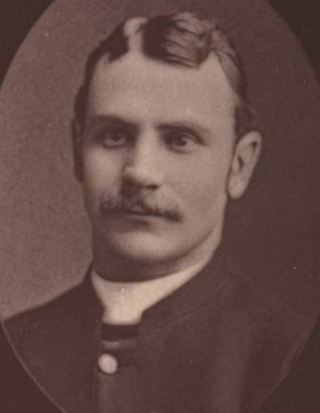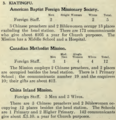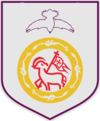
Mianyang is the second largest prefecture-level city of Sichuan province in Southwestern China. Located in north-central Sichuan covering an area of 20,281 square kilometres (7,831 sq mi) consisting of Jiangyou, a county-level city, five counties, and three urban districts. Its total population was 4,868,243 people at the 2020 Chinese census, of whom 2,232,865 live in its built-up area made of three urban districts.
OMF International is an international and interdenominational Evangelical Christian missionary society with an international centre in Singapore. It was founded in Britain by Hudson Taylor on 25 June 1865.

In the early 19th century, Western colonial expansion occurred at the same time as an evangelical revival – the Second Great Awakening – throughout the English-speaking world, leading to more overseas missionary activity. The nineteenth century became known as the Great Century of modern religious missions.

The West China Union University, also called West China University or Huaxi University, was a private university in Chengdu, Sichuan, China. It was the product of the collective efforts of four Protestant, denominational, missionary boards — American Baptist Foreign Mission Society, American Methodist Episcopal Mission, Friends' Foreign Mission Association and Canadian Methodist Mission — and eventually became a division of the West China Educational Union, which was created in 1906. The Church Missionary Society became a partner in the university in 1918.

William Wharton Cassels was an Anglican missionary bishop.

Christianity is a minority religion in the southwestern Chinese province of Sichuan. The Eastern Lipo, Kadu people and A-Hmao are ethnic groups present in the province.

David Crockett Graham was a polymath American Baptist minister and missionary, educator, author, archaeologist, anthropologist, naturalist and field collector in the Province of Sichuan during the Chinese Republican Era, from 1911 to 1948. He was a 32nd degree Mason, and a past master of the Szechwan Lodge No. 112. From 1921 to 1942, Graham collected and sent to the Smithsonian Institution nearly 400,000 zoological specimens, including more than 230 new species and 9 new genera, of which 29 were named after him. From 1932 to 1942 he was curator of the Museum of Art, Archaeology and Ethnology at the West China Union University, which still stands as part of Sichuan University, in Chengdu. There, he taught comparative religions at the Theological College, and archaeology and anthropology at the University. He wrote extensively and spent his retirement years, from 1950 to 1961, in Englewood, Colorado compiling his writings and research into three books that were published by the Smithsonian Institution. A fourth manuscript lay in the Whitman College and Northwest Archives until it was discovered by Hartmut Walravens, who edited it and published it in 2018. McKhann refers to Graham as "One of a handful of Western missionaries whose scientific work was respected by other scientists—and of even fewer scientists whose religious work was respected by other missionaries."

Thomas Torrance (1871–1959) was a Scottish Presbyterian minister and Protestant missionary to Sichuan, western China. He was first sent there by the China Inland Mission (CIM), and later by The American Bible Society. He married Annie Elizabeth Sharp (1883–1980) of the CIM in 1911. He was the father of the 20th century theologian, Thomas F. Torrance.

Gospel Church is a Protestant church building situated on Jiefang Street in Fucheng District, Mianyang. It was first built in 1895, or 1885 according to Annals of Religion in Mianyang, by Alfred Arthur Phillips and Gertrude Emma Wells, missionaries of the Church Missionary Society (CMS) under the jurisdiction of the Church of England. The church has been subjected to the control of the communist-established 'Three-Self Patriotic Church' since 1954. It was rebuilt in 1995.

St John's Church, today known as Shangxiang Christian Church, is a Protestant church situated on Shangxiang Street in the city of Chengdu, Sichuan Province. Founded in 1909, the church had been the seat of the Anglican Bishop of West Szechwan, practically making it the cathedral of this bishopric. It has been subjected to the control of the state-sanctioned Three-Self Patriotic Church since 1954.

The history of Anglicanism in Sichuan began in 1887 when Anglican missionaries working with the China Inland Mission began to arrive from the United Kingdom. These were later joined by missionaries from the Church Missionary Society and Bible Churchmen's Missionary Society. Or according to Annals of Religion in Mianyang, in 1885, a small mission church was already founded in Mianyang by Alfred Arthur Phillips and Gertrude Emma Wells of the Church Missionary Society. Missionaries built churches, founded schools, and distributed Chinese translations of Anglican religious texts. These efforts were relatively successful and Anglicanism grew to become one of the two largest denominations of Protestant Christianity in the province, alongside Methodism.
Holy Cross Church is a Protestant church situated on Tianlong Road in Wanzhou District, Chongqing. It was founded in 1923 by an American Lutheran missionary, Rev George Oliver Lillegard (1888–1965). It has been subjected to the control of the state-sanctioned Three-Self Patriotic Church since 1954.

The Protestant mission began in the southwestern Chinese province of Sichuan in 1877, when premises were rented by the China Inland Mission in Chungking. However, compared with Catholicism, which had been spread throughout the province for over two centuries at the time, it grew rather slowly, it was not until the late 1980s that Protestantism experienced rapid growth. The two largest denominations in the province before 1950 were Anglicanism and Methodism.

The presence of the Catholic Church in the southwestern Chinese province of Sichuan and city of Chongqing dates back to 1640, when two missionaries, Lodovico Buglio and Gabriel de Magalhães, through Jesuit missions in China, entered the province and spent much of the 1640s evangelizing in Chengdu and its surrounding areas.
The history of Methodism in Sichuan began in 1882 when missionaries began to arrive from the United States. Methodists founded or helped found several colleges, schools, and hospitals to aid in modernization and conversion efforts. Later, American Methodists were joined by missionaries from Canada. Methodism grew to become one of the two largest denominations of Protestant Christianity in the province by 1922, along with Anglicanism.

The history of Quakerism in Sichuan began in 1887 when missionaries began to arrive from the United Kingdom. Missionaries founded schools and established meeting groups. Nonetheless, missionary activity in China generated controversy among many native Chinese and faced armed opposition during both the Boxer Rebellion and the later Chinese Communist Revolution. Although the former did not affect Sichuan so much as some other parts of China, the province was one of the hotbeds of anti-missionary riots throughout its ecclesiastical history.

Sï-Shen-Tsï Methodist Church is a Protestant church situated on Sishengci North Street in the city of Chengdu, Sichuan Province. It is the first church in Chengdu built by the Canadian Methodist Mission. It has been subjected to the control of the state-sanctioned Three-Self Patriotic Church since 1954.

The West China Missionary News (WCMN) was a monthly news magazine published in Chengdu (Chengtu) from 1899 to 1943 by the West China Missions Advisory Board, and printed by Canadian Methodist Mission Press. It was aimed at Protestant missionaries working in Sichuan, and was the first and longest-running English-language newspaper in that province.
The history of Adventism in Sichuan began in 1914 when American and Chinese missionaries arrived in Chongqing. Adventist missionaries in Sichuan were organized under the Szechwan Mission, later split into the East Szechwan, West Szechwan, and Tibetan Missions. Missionary activity in China generated controversy among many native Chinese and faced opposition from popular riots and the later Communist movement in China. Numerous mission properties and native Church leaders in Sichuan were respectively destroyed and killed by communists in the mid-1930s. Missionary activity ceased after the communist take over of China in 1949. Under government oppression in the 1950s, Adventist congregations and other Protestant Churches across China severed their ties with overseas Churches, and their congregations subsequently merged into the Three-Self Patriotic Church. Since 1980, their services have been provided by the China Christian Council.























